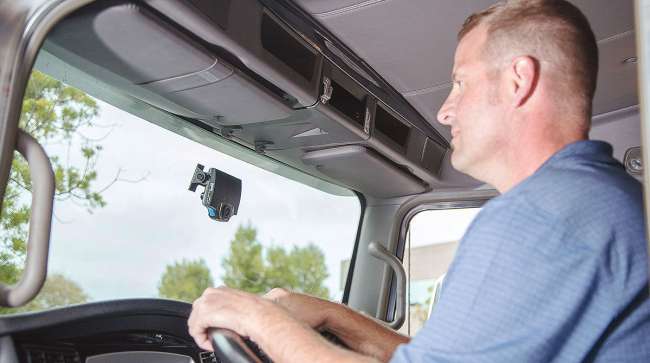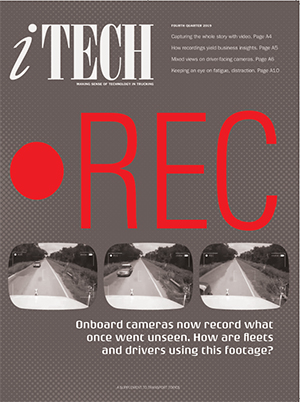Some Fleets Reluctant to Add Driver-Facing Cameras

[Stay on top of transportation news: Get TTNews in your inbox.]
The use of onboard video technology is increasing in the trucking industry, but many fleets remain reluctant to add driver-facing cameras due to concerns over privacy and driver recruitment and retention.
Almost 30% of SmartDrive’s new customers start with three cameras — road-facing, driver-facing, and either a side or rear camera, said Steve Mitgang, the technology provider’s CEO.
In contrast, only about 4% of Trimble’s customers have deployed a driver-facing camera, but about 35% are using right- and left-side cameras, said Jim Angel, vice president of video intelligence solutions at the company.
Because the video system is integrated with the onboard telematics system, carriers don’t need to see the driver to get a full sense of what is happening, Angel added.

Fourth Quarter iTECH
- A Witness in the Cab
- Some Fleets Reluctant to Add Driver-Facing Cameras
- Analysis of Onboard Video Can Yield Operational Insights
- Self-Driving Trucks and Presidential Politics
- Driver Training, Monitoring Could Help Ensure Safe Testing, Deployment of Automated Trucks
- In-Cab Monitoring Uses Machine Vision to Detect Fatigued, Distracted Driving
However, Jeremy Stickling, chief administrative officer for Nussbaum Transportation, said he believes inward-facing cameras help provide the full story of what happened.
“You wouldn’t read half of a book,” he said.
Nussbaum once had a driver involved in a suicide-by-truck fatality.
“A man jumped out from a ditch in front of him,” Stickling said. “That driver, to process his grief, wanted to see what he was doing. He had his hands on the wheel, eyes on the road and had a quick response. That helped us more than just an outward camera would have, and personally, it helped that driver process the trauma of what happened.”
When Nussbaum first installed driver-facing cameras from SmartDrive in 2014, it was a big issue, Stickling said. Five years later, it is almost a nonissue when talking to drivers, he said.
The use of driver-facing cameras is often dependent on a carrier’s relationship with their drivers and the culture.
“If there is already a positive retention climate, drivers may be more trusting of management’s desire to install driver-facing as well as road-facing cameras,” said Mark Schedler, senior editor in transport management at J.J. Keller & Associates.
To bolster driver acceptance of inward-facing cameras, carriers should focus on recognizing good driving behaviors and improving fleet performance and stress the potential for exoneration, Schedler said. Fleets also have to ensure that driver privacy is protected.
The use of driver-facing cameras can vary by industry, said Jai Ranganathan, vice president of products at KeepTruckin.
“Private fleets tend to be more interested in driver-facing as well as forward-facing. For-hire fleets are less interested,” he said.
A higher percentage of local distribution fleets have inward-facing cameras, said Del Lisk, vice president of safety services for Lytx.
“For the majority of clients with the dual view, they see that as being a more proactive tool. For those with the road view, they know it would be a more powerful safety solution, but they generally hold off because that market has challenges in getting and keeping drivers,” Lisk said, adding that it is often an unnecessary concern. “The ones that do go dual view say they really didn’t lose anyone.”
Trimble’s Angel, on the other hand, said driver-facing video could harm a driver or a fleet in the event of a crash.
“Somebody could slam into your driver in your truck, and the plaintiff’s attorney will make it about your driver not having two hands on the wheel. It won’t have anything to do with the accident, but then they’ll ask for six months or more of history on that driver,” he said, adding that the information could make a driver look bad.
However, for some carriers, such as those that haul hazardous materials, the driver-facing cameras may make sense, Angel said.
SmartDrive’s Mitgang said side cameras could help fleets identify operational risk, such as damage.
“Claims in a railyard are rarely filed because there is usually little evidence. Now you have additional views that really are helpful,” he said.
Want more news? Listen to today's daily briefing:

